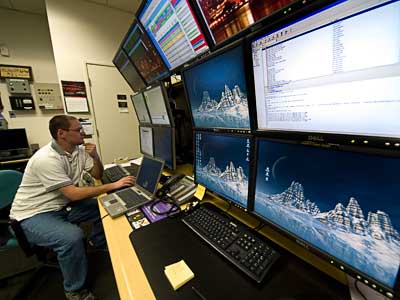New supercomputer might help scientists identify the sound of black holes
 Washington, Feb 10: A new supercomputer, being assembled at Syracuse University (SU), may help scientists identify the sound of a celestial black hole.
Washington, Feb 10: A new supercomputer, being assembled at Syracuse University (SU), may help scientists identify the sound of a celestial black hole.
Dubbed SUGAR (SU Gravitational and Relativity Cluster), the supercomputer will soon receive massive amounts of data from the California Institute of Technology
(Caltech), collected over a two-year period at the Laser Interferometer Gravitational-Wave Observatory (LIGO).
SUGAR is a collection of 80 computers, packing 320 CPUs of power and 640 Gigabytes of random access memory. It also has 96 terabytes of disk space on which to store the LIGO data.
The LIGO data will be used to detect gravitational waves, which are produced by violent events in the distant universe, such as the collision of black holes or explosions of supernovas.
While Albert Einstein predicted the existence of these waves in 1916 in his general theory of relativity, it has taken decades to develop the technology to detect them.
But with the construction of the LIGO detectors in Hanford, Washington, and Livingston in 2005, the search for data for these waves has been made possible.
LSC (LIGO Scientific Collaboration) scientists will be now analyzing this data while the sensitivity of the detectors is being improved.
Before they can isolate the sound of a black hole from the LIGO data using the new supercomputer, the scientists must figure out what a black hole sounds like.
For this, Duncan Brown, assistant professor of physics and member of SU's Gravitational Wave Group, will use SUGAR and Einstein's equations to create models of gravitational wave patterns from the collision of two black holes.
"Looking for gravitational waves is like listening to the universe," said Brown. "Different kinds of events produce different wave patterns. We want to try to extract a wave pattern - a special sound - that matches our model from all of the noise in the LIGO data," he added.
Both the supercomputer and the high-speed network are expected to be up and running by the end of February 2008.
Once the data is transferred to SU from Caltech, Brown and his LSC colleagues will begin to listen to the "cosmic symphony."
"Gravitational waves can teach us much about what is out there in the universe," said Brown. "We've never looked at Einstein's theory in this way," he added. (ANI)